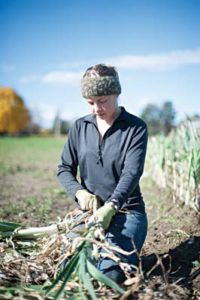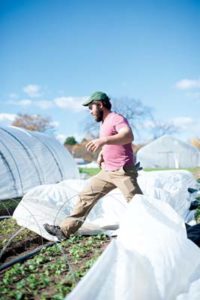 |
| Kelsey Herrington of MOFGA-certified organic Two Farmers Farm in Scarborough is among the skilled new farmers in Maine. In this photo she is harvesting and preparing leeks for market. |
 |
| Along with Herrington, Dominic Pascarelli of Two Farmers Farm strives for efficient crop production. |
By Stowell Watters
Photos by Lily Piel
Every five years the U.S. Department of Agriculture compiles an official Census of Agriculture so that we, as a nation, might check under the hood of our agricultural goings-on. It gathers information from the 2.2 million U.S. farms and jams it into graphs and data sets.
The last Census, conducted in 2012, showed that the American farmer is growing older and fewer young people are farming. According to that census, the average U.S. farmer was about 58 years old (57 in Maine), while 30 years ago the average age was 50, nationwide and in Maine. (In fact, the average age of the entire U.S. workforce is increasing. Whether due to financial hardship or the emergence of beneficial technologies, people are working longer and retiring older.)
In the 1970s, one-third of U.S. farmers were under the age of 46; in 2012, 16 percent, and only 0.3 percent were under 25.
Maine is an exception, where the number of farmers aged 34 and younger increased almost 40 percent between 2007 to 2012, while the increase nationally was only 1.5 percent.
Kelsey Herrington, 29, and Dominic Pascarelli, 30, of Two Farmers Farm in Scarborough are among those new, young Maine farmers. They have operated the aptly named farm for five years, with no plans to stop.
Extensive Farming Backgrounds and Training
Both grew up in farming communities – Herrington on Vashon Island, Washington, and Pascarelli in Durham, Maine, where his parents have long been involved with the Sagadahoc MOFGA chapter. In fact his father, Mario Pascarelli, with help from his vocational education students in Lewiston, made many of the picnic tables at MOFGA’s Common Ground Education Center.
The couple met in their early 20s while working toward masters’ degrees in environmental science and policy at Clark University. At the time Herrington was researching sustainable meat production while working for a local farm, and Pascarelli was a youth mentor for an urban gardening program and was a core organizer for Clark’s food waste composting system.
They then apprenticed on farms in New England, ending up in New York at Paul and Sandy Arnold’s Pleasant Valley Farm, famous for its success with year-round vegetable production and for those farmers’ thorough analyses of profitable crops. (See “Building a Profitable Small Farm” in the spring 2011 issue of The Maine Organic Farmer & Gardener.)
Herrington said that once they saw what was possible in the harsh winters of upstate New York, they knew they could grow in Maine.
“Growing in winter is something we knew we wanted to focus on,” she said.
Saving Money, Finding Land, Getting Ready
In 2011 and 2012, the two were living in the old mill town of Saco. Herrington worked as a full-time nanny, and Pascarelli spent his days looking for land and nights shoveling snow and spreading salt. They grew some crops on nearby family-owned land, and they joined MOFGA’s journeyperson program, with Mary Ellen and Austin Chadd of Green Spark Farm as mentors one year, and Nate Drummond and Gabrielle Gosselin of Six River Farm in Bowdoinham another year. (Drummond and Gosselin had also apprenticed with Paul and Sandy Arnold.)
“We worked full-time all winter making plans, budgets, procuring equipment, etc. (while also growing and selling winter produce),” said the two in a summary of their business for The Carrot Project. “This preparation set us up well for the first season.”
To save money, they hunkered down and practiced a bit of old fashioned privation.
“We have just always been good at recognizing what we could live without,” Herrington said.
“Yeah, it was like, the heat is going to be at 58 degrees, so just deal with it, grab a sweater,” Pascarelli said, adding, “we wanted any extra bit of money to go toward the farm. It was the most important thing in our life and it still is.”
They had the skills and knowledge. They had the plan. All they needed was a place to set it all in motion. They enlisted the help of Land for Good, a nonprofit consulting and educational organization that helps prospective farmers throughout New England find their patch of land.
They finally found land to lease in Scarborough at the head of the Nonesuch River, which rises in Saco and provides freshwater to the Scarborough Marsh before draining into the sea at Prouts Neck. The property spreads from the road toward the sea and is slightly elevated on the eastern side but for the most part very gentle. Leasing and not having a mortgage has enabled them to put more money into the farm.
Growing the Farm
In 2013 they moved to the land, and family and farmer friends helped with labor as the farm got started. Over time they put up a greenhouse and four 96-foot-long high tunnels (with some funding from Slow Money Maine) and grew to the point where this summer they were able to hire two full-time employees. They now grow about 5 acres of MOFGA-certified organic vegetables and manage about 15 acres of farmland in total. They market through five farmers’ markets (in Kennebunk and Portland, Maine, and in Exeter and Rollinsford, N.H.), to wholesalers (including The Farm Stand, Jordan Farm’s farm stand, the Portland Food Coop, Lois’ Natural Marketplace and Rosemont Market) and to chefs.
The Southern Maine land they farm is near the beaches of Saco and Scarborough. On windy days the smell of the ocean rolls through the trees and over their sandy soil.
“Some days it’s like we are actually walking on the beach,” said Herrington.
This year’s drought made their soils especially difficult to manage, requiring constant attention to irrigation. Organic matter oxidizes quickly in sandy soils, so the two farmers add healthy doses of compost to their soil every year to keep up with nutrient demand and to help hold moisture.
Despite these issues, Herrington and Pascarelli are happy to be free of the rocks that litter the fields and lurk just beneath the surface of most Maine farms. Like most farmers they speak of their soil with authority and something akin to love. Pascarelli smiles as he affirms that most of their land is Windsor sandy loam.
“We can grow parsnips this long,” Herrington said, holding her hands nearly a foot apart.
They draw their irrigation water from a nearby brook and take lunch beneath a tall American elm tree that seems to buffet their farm perfectly from the bustling traffic of Route 1.
“We are right in the middle of all these great markets, but if you turn your body like this, it’s all farmland and wilderness,” Pascarelli said, pivoting with his back to the road.
The two have carved out a quiet refuge in the middle of the most densely populated part of the state – a place where they can grow food not only for the booming summer crowds, but for the winter warriors as well.
Two Farmers Farm is not a seasonal endeavor. For Herrington and Pascarelli this is a point of particular pride. Growing vegetables all winter on the southern coast of Maine is no walk in the park; icy temperatures and sharp winds coming off the Atlantic give much of the population reason to head south across state lines until spring. Staying put on the farm means that Herrington and Pascarelli get very familiar with the snow shovel, digging their way through drifts in an effort to keep the unheated high tunnels pumping out greens for winter markets. Their goals are to sell for 48 to 50 weeks of the year, to spread out the work of farming, to have some time for vacations and to avoid excess stress.
As for their next big move, Pascarelli seems happy to just hold on.
“Yeah, hopefully no more big projects, maybe just do some tweaking,” he said.
“Well, we are hiring a full-time employee to work throughout the winter, so there is that,” Herrington said.
“Oh yeah, we are doing that too,” Pascarelli said.
In the future they hope to create a farm that is so simple and straightforward that any new employee could come in and quickly understand how to do whichever task needs to be done. From their expertly washed and bagged salad greens and carrots to their neat rows of growing vegetables stretching in every direction, they want the work to be clear and easy so that they can focus on that tweaking – of growing and of marketing.
About the author: Stowell P. Watters, also a former MOFGA journeyperson, runs Old Wells Farm with his family in Limington, Maine.
